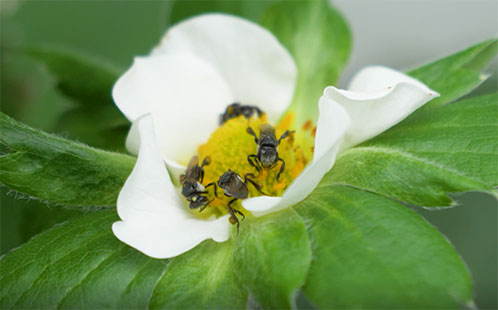Glasshouse pollination trials with native bees bear abundant fruit

Recent glasshouse trials at Western Sydney University have found that native bees can be effective pollinators for strawberry crops in fully-enclosed protected cropping environments.
Using colonies of native Tetragonula bees in strawberry trials, researchers have been able to demonstrate that native bees make safe and efficient pollinators and result in good-quality yields of strawberries.
The native bees are introduced to the glasshouse before crops are planted and provided with food and water. This helps them to acclimate to the enclosed environment and become used to the food sources available inside the enclosed glasshouse rooms. Once the strawberries flower, the native bees visit the flowers and researchers measure the connection between bee visits and subsequent fruit yield, quality and size.
"Crop pollination in glasshouses has always been a challenge because European honeybees are not well-suited to the enclosed environment and other pollinating insects are usually excluded by the glass or other coverings", said Dr Mark Hall at the Hawkesbury Institute for the Environment.
"This has traditionally meant pollinating by hand which requires significant manual labour or using self-pollinating varieties", Mark said.
The search for a wider variety of pollinators in a range of cropping environments is part of a national push to identify alternatives to European honeybees and assess the potential for using Australia’s many native pollinators more effectively.
"Australia is home to around 2000 species of native bees as well as thousands of species of pollinating moths, flies, butterflies, birds and even bats that all contribute to native and managed ecosystem pollination", said Prof James Cook, lead scientist of the pollination research program at Western Sydney University.
"As the horticulture industry innovates into the future, a wider range of protected cropping environments will become the new normal with growers using tunnels, glasshouses, shelters and shade houses to modify the cropping environment for high-value crops such as leafy greens, herbs, berries and some vegetables", James said.
ENDS
14 November 2019
David Thompson, Research Communications & Media Officer
The National Vegetable Protected Cropping Centre at Western Sydney University, and its associated research projects, are funded by Hort Innovation using grower levies and funds from the Australian Government, with co-investment from Western Sydney University.
"Stingless bees as effective managed pollinators for Australian horticulture" is funded by the Hort Frontiers Pollination Fund, part of the Hort Frontiers strategic partnership initiative developed by Hort Innovation, with co-investment from Western Sydney University, Bayer CropScience, Syngenta Asia-Pacific and Greening Australia, and contributions from the Australian Government.
Mobile options:

